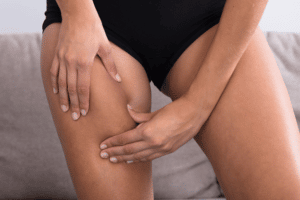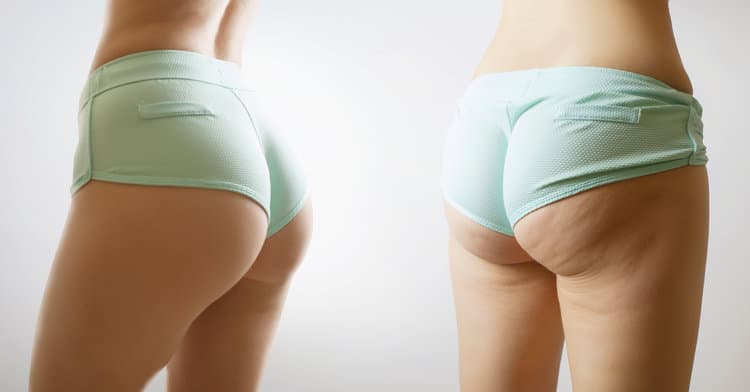“Cottage cheese,” “funky gravy,” “hail damage”—whatever your preferred term, cellulite is something most of us would rather not see on our bodies.
That lumpy, dimpled skin tends to show up on our thighs, buttocks, abdomen, and hips, and it doesn’t discriminate.
Whether you’re young or old, slim or full-figured, man or woman, the appearance of cellulite can leave you feeling a bit uneasy—or downright embarrassed.

Here’s the deal: cellulite happens when fat cells push up against the skin while fibrous connective cords pull down, creating a dimpled effect.
It’s not about weight; it can affect anyone, regardless of shape, size, or age. In fact, between 80 to 90 per cent of women will experience cellulite at some point.
Some folks even start noticing it as early as puberty. For those feeling embarrassed about cellulite, you’re far from alone.
So, What’s the Plan?
We turned to Dr. Gretchen Frieling, a Boston-based, board-certified dermatopathologist, who knows what’s what when it comes to dealing with cellulite.
She’s sifted through the clutter to pinpoint what actually works, whether you’re after a quick fix or a more permanent solution.
1. At-Home Creams: The DIY Route
“If you’re looking for an at-home treatment, topical creams are an effective way to diminish cellulite.
However, they’re a long-term or complete ‘cure,'” says Dr. Frieling. She adds, “The fat cells are still under there! To maintain the results, you’ll have to apply the product every day.”
To see results, use a moisturizing cream with ingredients like caffeine or retinol. Caffeine works as a diuretic, dehydrating fat cells to reduce their appearance.
Retinol, meanwhile, thickens the outer skin layer, making cellulite less visible. But keep in mind: test these products first to avoid adverse reactions. Most of these creams can be picked up online or at your local drugstore.
2. Cutting-Edge Technology: The Medical Approach
- Acoustic Wave Therapy: This treatment uses sound waves to break up cellulite. Several sessions are needed, but studies suggest it works.
- Cellulaze™: This laser treatment breaks up the tough bands under the skin that cause dimpling. The added benefit? It thickens the skin, which can help smooth out the bumps. Results last a year or more, but more research is needed to confirm its long-term effectiveness.
- Cellfina™: A dermatologist inserts a tiny needle beneath the skin to cut the tough bands. In a study, 99% of patients were satisfied with their results, which can last two years or more.
- Vacuum-Assisted Precise Tissue Release: This involves a device with small blades that cut the bands, allowing the skin to spring back and smooth out. Some patients report less cellulite for up to three years.
- Radiofrequency Treatments: This technique heats the skin and fat cells to reduce cellulite. It’s a short-lived solution, requiring several sessions, but some folks see a modest improvement.
3. Lifestyle Adjustments: Small Changes, Big Impact
- Avoid Sugar: “Your diet may play a significant role in the amount of cellulite you have,” explains Dr. Frieling. Too much sugar and processed food can make fat cells swell, creating more noticeable cellulite. Also, beware of high-sodium foods that cause bloating and water retention.
- Exercise Regularly: While it’s not a cure, regular exercise helps by strengthening muscles under the fat, making the skin appear smoother. Think squats, lunges, and brisk walks to target those leg muscles.
- Stop Smoking: Smoking reduces blood flow to the skin, making it thinner and saggy. Quitting can help improve skin texture over time.
- Reduce Alcohol Consumption: “Cutting down on alcohol helps decrease the toxins that build up under fat cells,” says Dr. Frieling. Plus, alcohol is packed with sugar, which only makes things worse.
- Stay Hydrated: You’ve heard it before: drink water! It flushes out toxins and improves overall skin health, making it look fuller and more even.
4. Fake It ‘Til You Make It
If you’ve got fair skin, a self-tanner can work wonders. The darker the skin, the less noticeable the dimples.
Start with a gentle scrub, then apply self-tanner to the affected areas. Just steer clear of a real tan; it could damage your skin and make cellulite more visible.
The Bottom Line: Embrace the Skin You’re In
Cellulite isn’t a reflection of your health, beauty, or worth. It’s simply a common skin condition that most of us deal with, and feeling embarrassed about cellulite shouldn’t hold you back.
Whether you opt for creams, treatments, lifestyle changes, or just a good old self-tanner, there’s no one-size-fits-all solution.
But with the right approach, you can manage and even reduce the appearance of those pesky dimples.





